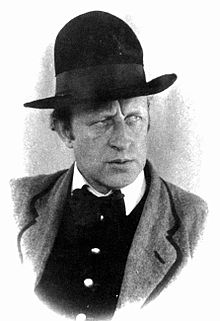Johannes Buchholtz
Johannes Buchholtz (born February 22, 1882 in Odense , † August 5, 1940 in Struer ) was a Danish writer .
Having grown up in Middelfart , Buchholtz came to Struer in 1902, where he worked as a secretary for the state railway company Danske Statsbaner . In 1908 he married Olga, with whom he moved into a house in 1911 that he had designed himself. It was to become a popular gathering place for poets and writers from the Limfjord region, including Jeppe Aakjær , Thøger Larsen , Johan Skjoldborg and Johannes V. Jensen . The villa at Søndergade 23 is now part of the Struer City Museum and can be visited.
Johannes Buchholtz began his writing career in 1915 with the novel Egholms Gud . In the following years he wrote many more books, so that in 1924 he gave up his work on the railroad and could devote himself entirely to writing. During his lifetime Johannes Buchholtz was one of the most widely read writers in Denmark. He was certified as having an "intimate familiarity with the milieu of the Danish provinces".
Works (selection)
- Egholms Gud ( Ger. Egholms Gott ); Novel , 1915.
- The miracles of Klara van Haag ; Roman, 1928.
- Dr. Malte and the small town ; novel
- Good little town. Novel . Translated from the Danish by Gustav Morgenstern . Cotta, Stuttgart 1939.
- Dr. Malthe's house. Novel . Translated from the Danish by Gustav Morgenstern. Cotta, Stuttgart 1940.
- The flower house ; Comedy in four acts.
Web links
- Museum in Struer (Danish)
- Literature by and about Johannes Buchholtz in the catalog of the German National Library
Individual evidence
- ↑ Lone Klem / Erling Nielsen: Navne i dansk Litteratur , Copenhagen 1970, p. 34
| personal data | |
|---|---|
| SURNAME | Buchholtz, Johannes |
| BRIEF DESCRIPTION | Danish writer |
| DATE OF BIRTH | February 22, 1882 |
| PLACE OF BIRTH | Odense |
| DATE OF DEATH | 5th August 1940 |
| Place of death | Struer |
